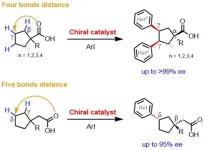(Press-News.org) **Embargo: 23.30 [UK time], 6:30 p.m. [EDT] May 16, 2024**
Global Burden of Disease
The latest findings from the Global Burden of Disease Study (GBD) 2021, published today in The Lancet, forecast that global life expectancy will increase by 4.9 years in males and 4.2 years in females between 2022 and 2050.
Increases are expected to be largest in countries where life expectancy is lower, contributing to a convergence of increased life expectancy across geographies. The trend is largely driven by public health measures that have prevented and improved survival rates from cardiovascular diseases, COVID-19, and a range of communicable, maternal, neonatal, and nutritional diseases (CMNNs).
This study indicates that the ongoing shift in disease burden to non-communicable diseases (NCDs) – like cardiovascular diseases, cancer, chronic obstructive pulmonary disease, and diabetes – and exposure to NCD-associated risk factors – such as obesity, high blood pressure, non-optimal diet, and smoking – will have the greatest impact on disease burden of the next generation.
As the disease burden continues to shift from CMNNs to NCDs and from years of life lost (YLLs) to years lived with disability (YLDs), more people are expected to live longer, but with more years spent in poor health. Global life expectancy is forecasted to increase from 73.6 years of age in 2022 to 78.1 years of age in 2050 (a 4.5-year increase). Global healthy life expectancy (HALE) – the average number of years a person can expect to live in good health – will increase from 64.8 years in 2022 to 67.4 years in 2050 (a 2.6-year increase).
To come to these conclusions, the study forecasts cause-specific mortality; YLLs; YLDs; disability-adjusted life years (DALYs, or lost years of healthy life due to poor health and early death); life expectancy; and HALE from 2022 through 2050 for 204 countries and territories.
“In addition to an increase in life expectancy overall, we have found that the disparity in life expectancy across geographies will lessen,” said Dr. Chris Murray, Chair of Health Metrics Sciences at the University of Washington and Director of the Institute for Health Metrics and Evaluation (IHME). “This is an indicator that while health inequalities between the highest- and lowest-income regions will remain, the gaps are shrinking, with the biggest increases anticipated in sub-Saharan Africa.”
Dr. Murray added that the biggest opportunity to speed up reductions in the global disease burden is through policy interventions aimed to prevent and mitigate behavioral and metabolic risk factors.
These findings build upon the results of the GBD 2021 risk factors study, also released today in The Lancet. This accompanying study found that the total number of years lost due to poor health and early death (measured in DALYs) attributable to metabolic risk factors has increased by 50% since 2000. on the risk factors report at https://bit.ly/GBDRisks2021.
The study also puts forth various alternative scenarios to compare the potential health outcomes if different public health interventions could eliminate exposure to several key risk factor groups by 2050.
“We forecast large differences in global DALY burden between different alternative scenarios to see what is the most impactful on our overall life expectancy data and DALY forecasts,” said Dr. Stein Emil Vollset, first author of the study who leads the GBD Collaborating Unit at the Norwegian Institute of Public Health. “Globally, the forecasted effects are strongest for the ‘Improved Behavioral and Metabolic Risks’ scenario, with a 13.3% reduction in disease burden (number of DALYs) in 2050 compared with the ‘Reference’ (most likely) scenario.”
The authors also ran two more scenarios: one focused on safer environments and another on improved childhood nutrition and vaccination.
“Though the largest effects in global DALY burden were seen from the 'Improved Behavioral and Metabolic Risk’ scenario, we also forecasted reductions in disease burden from the ‘Safer Environment’ and ‘Improved Childhood Nutrition and Vaccination’ scenarios beyond our reference forecast, said Amanda E. Smith, Assistant Director of Forecasting at IHME. “This demonstrates the need for continued progress and resources in these areas and the potential to accelerate progress through 2050.”
“There is immense opportunity ahead for us to influence the future of global health by getting ahead of these rising metabolic and dietary risk factors, particularly those related to behavioral and lifestyle factors like high blood sugar, high body mass index, and high blood pressure,” continued Dr. Murray.
Notes to editors
For interview requests, journalists may contact ihmemedia@uw.edu. For full study results, including the paper and related tables, finalized PDFs are available at https://bit.ly/GBD2021Forecast, embargoed until 23:30 UK, 6:30 p.m. EDT on May 16, 2024. The post-embargo link for the paper is https://www.thelancet.com/journals/lancet/article/PIIS0140-6736(24)00685-8/fulltext. An infographic summarizing the study’s findings can be found at https://bit.ly/4byxttL. Data tables containing estimates from the study are available at https://ghdx.healthdata.org/record/ihme-data/global-life-expectancy-all-cause-mortality-and-cause-specific-mortality-forecasts-2022-2050.
About the Institute for Health Metrics and Evaluation
The Institute for Health Metrics and Evaluation (IHME) is an independent research organization at the University of Washington (UW). Its mission is to deliver to the world timely, relevant, and scientifically valid evidence to improve health policy and practice. IHME carries out its mission through a range of projects within different research areas including the Global Burden of Diseases (GBD), Injuries, and Risk Factors; Future Health Scenarios; Cost Effectiveness and Efficiency; Resource Tracking; and Impact Evaluations.
IHME is committed to providing the evidence base necessary to help solve the world’s most important health problems. This requires creativity and innovation, which are cultivated by an inclusive, diverse, and equitable environment that respects and appreciates differences, embraces collaboration, and invites the voices of all IHME team members.
About the Global Burden of Disease Study
The Global Burden of Disease Study (GBD) is the largest and most comprehensive effort to quantify health loss across places and over time. It draws on the work of more than 11,000 collaborators across more than 160 countries and territories. GBD 2021 – the newly published most recent round of GBD results – includes more than 607 billion estimates of 371 diseases and injuries and 88 risk factors in 204 countries and territories. The Institute for Health Metrics and Evaluation coordinates the study.
END
Global life expectancy to increase by nearly 5 years by 2050 despite geopolitical, metabolic, and environmental threats, reports new global study
2024-05-17
ELSE PRESS RELEASES FROM THIS DATE:
High primary health coverage significantly reduces child mortality in Latin America
2024-05-17
The implementation of primary health care (PHC) over the last two decades has prevented more than 300,000 child deaths in four Latin American countries, and could prevent more than 140,000 by 2030 in a scenario of economic crisis. This is the main conclusion of a study coordinated by the Barcelona Institute for Global Health (ISGlobal), a centre supported by “la Caixa” Foundation, published in The Lancet Global Health.
The 2018 Astana Declaration highlighted the critical role of PHC in ensuring that everyone enjoys the highest possible standard of health, and in achieving universal health coverage. The Declaration also stressed the ...
Ubiquitin trailblazer elected Fellow of prestigious Royal Society
2024-05-17
WEHI division head and pioneer of ubiquitination Professor David Komander has been elected a Fellow of the esteemed Royal Society, the UK’s national science academy.
Prof Komander was recognised for his significant research contributions towards understanding ubiquitin, the ‘kiss of death’ protein which tells our cells which proteins to break down or recycle – a vital process that helps cells stay healthy and function correctly. Prof Komander’s work has helped unravel the ‘ubiquitin code’ that enables ubiquitin to perform many ...
A new ‘rule of biology’ may have come to light, expanding insight into evolution and aging
2024-05-17
By Darrin S. Joy
A molecular biologist at the USC Dornsife College of Letters, Arts and Sciences may have found a new “rule of biology.”
A rule of biology, sometimes called a biological law, describes a recognized pattern or truism among living organisms. Allen’s rule, for example, states that among warm-blooded animals, those found in colder areas have shorter, thicker limbs (to conserve body heat) than those in hotter regions, which need more body surface area to dissipate heat.
Zoologist Joel Allen formulated this idea in 1877, and though he wasn’t the first or the last to present a rule of biology, his ...
Scripps Research chemists develop new method for making gamma chiral centers on simple carboxylic acids
2024-05-17
LA JOLLA, CA—Scripps Research chemists have accomplished a long elusive feat in synthetic chemistry: the invention of a broadly useful method for constructing “gamma chiral centers” on simple starting compounds called carboxylic acids. The method, published on May 16, 2024 in Science, significantly extends the ability of chemists to build and modify complex pharmaceutical molecules and other valuable chemical products.
The term chiral refers to a type of asymmetry that allows some chemical compounds to exist in left-handed and right-handed forms. Often, only one of these forms has the ...
2024 SIAM Annual Meeting (AN24) with online component including SIAM Conference on Discrete Mathematics (DM24) and the SIAM Conference on Applied Mathematics in Education (ED24)
2024-05-16
The SIAM Annual Meeting provides a broad view of the state of the art in applied mathematics, computational and data science, and their applications through invited presentations, prize lectures, minitutorials, minisymposia, contributed presentations, and posters. END ...
Detecting influence campaigns on X with AI and network science
2024-05-16
In the age of generative-AI and large language models (LLMs), massive amounts of inauthentic content can be rapidly broadcasted on social media platforms. As a result, malicious actors are becoming more sophisticated, hijacking hashtags, artificially amplifying misleading content, and mass resharing propaganda.
These actions are often orchestrated by state-sponsored information operations (IOs), which attempt to sway public opinion during major geopolitical events such as the US elections, the Covid-19 pandemic, and more.
Combating ...
Offering both colonoscopy and at-home tests doubled colorectal cancer screening
2024-05-16
The rate of colorectal cancer screenings more than doubled when patients were given a choice between which type of screening they wanted—a take-home kit or colonoscopy—compared to those who were only offered the colonoscopy, according to new research led by the Perelman School of Medicine at the University of Pennsylvania. Facilitated through a community health center in which about half of patients had Medicaid insurance, the study—published in Clinical Gastroenterology and Hepatology—provides insights about how to boost screenings among groups ...
A powerful tool speeds success in achieving highly efficient thermoelectric materials
2024-05-16
HOUSTON, May 16, 2024 – Thermoelectric materials could play an important role in the clean energy transition, as they can produce electricity from sources of heat that would otherwise go to waste without generating additional greenhouse gases or requiring large up-front investment. But their promise has been slowed by the fact that most current thermoelectric materials don’t efficiently produce enough power to be useful for many practical applications.
The search for new, more efficient materials involving complex chemical ...
Oropharyngeal cancer staging health record extraction using AI
2024-05-16
About The Study: The results of this study suggest that artificial intelligence may be associated with enhanced patient care and oncological decision-making in patients with oropharyngeal squamous cell carcinoma through detection of localized versus advanced cancer stages. Further model refinement and external validation with electronic health records at different institutions are necessary to improve algorithm accuracy and clinical applicability.
Corresponding Author: To contact the corresponding author, Antoine Eskander, M.D., email antoine.eskander@mail.utoronto.ca.
To access the ...
Airborne technology developed at USC brings new hope to map shallow aquifers in Earth’s most arid deserts
2024-05-16
Water shortages are expanding across the Earth. This is particularly acute in desert areas of the Middle East that are subject to both drought and extreme conditions such as flooding. As a result of these uncertainties, there is an increasing reliance on shallow aquifers to mitigate these shortages. However, the characteristics of these aquifers remain poorly understood due to the reliance on sporadic well logs for their management.
To address this challenge a team of researchers at the USC Viterbi School of Engineering Ming Hsieh Department of Electrical and Computer Engineering along with collaborators ...



